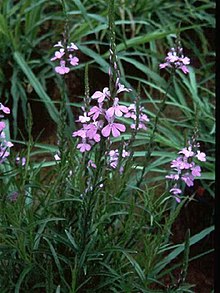Striga hermonthica
| Purple witchweed | |
|---|---|
 |
|
| Striga hermonthica flowers | |
| Scientific classification | |
| Kingdom: | Plantae |
| (unranked): | Angiosperms |
| (unranked): | Eudicots |
| (unranked): | Asterids |
| Order: | Lamiales |
| Family: | Orobanchaceae |
| Genus: | Striga |
| Species: | S. hermonthica |
| Binomial name | |
|
Striga hermonthica (Delile) Benth. |
|
Striga hermonthica, commonly known as purple witchweed or giant witchweed, is a hemiparasitic plant that belongs to the family Orobanchaceae. It is devastating to major crops such as sorghum (Sorghum bicolor) and rice (Oryza sativa). In sub-Saharan Africa, apart from sorghum and rice, it also infests maize (Zea mays), pearl millet (Pennisetum glaucum), and sugar cane (Saccharum officinarum).
Striga hermonthica has undergone horizontal gene transfer from Sorghum to its nuclear genome. The S. hermonthica gene, ShContig9483, is most like a Sorghum bicolor gene, and additionally shows significant but lesser similarity to a gene from Oryza sativa. It shows no similarity to any known eudicot gene.
Purple witchweed infects a variety of grasses, and legumes in sub-saharan Africa including rice, maize, millet, sugarcane, and cowpea. The symptoms mimic that of drought or nutrient deficiency symptoms. Chlorosis, wilt, and stunting result from witchweed’s ability to extract nutrients from its host. Pre-emergence symptoms are difficult to diagnose secondary to their similarity to general lack of nutrients. Once emergence of the plant has taken place, it is usually too late to mitigate damage.
Seeds of witchweed overwinter in the soil after they are dispersed by wind, water, animal, or human machinery. When the environment is correct, and if the seed is within a few centimeters of the host root, it will begin to germinate. The germinating plant grows towards hormones, called strigolactones, released from the host root. The plant grows up the concentration gradient of these strigolactones. In the absence of strigolactone, the striga will not germinate. Strigolactone knockout plants have been used in an attempt to prevent infection by avoiding germination. Once in contact with the root, the witchweed produces a haustorium establishing a parasitic relationship with the plant. It remains underground for several weeks while extracting nutrients. The stem while underground is round and white. After this stage it emerges from the ground and rapidly flowers and produces seeds. The flowers self pollinate before opening. Post emergence the plant can perform photosynthesis to augment its metabolic demands.
...
Wikipedia
